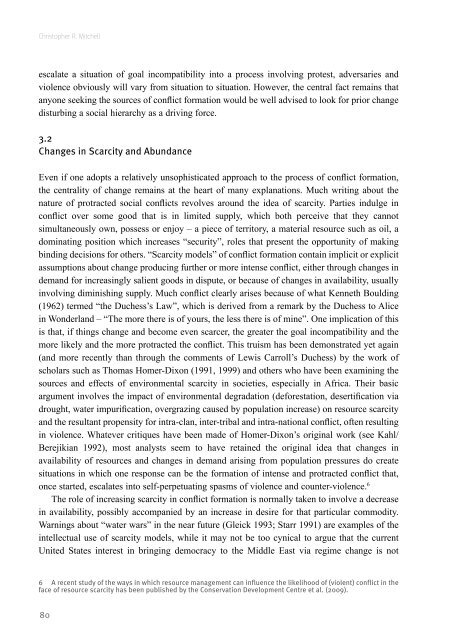Conflict, Change and Conflict Resolution - Berghof Handbook for ...
Conflict, Change and Conflict Resolution - Berghof Handbook for ...
Conflict, Change and Conflict Resolution - Berghof Handbook for ...
You also want an ePaper? Increase the reach of your titles
YUMPU automatically turns print PDFs into web optimized ePapers that Google loves.
Christopher R. Mitchell<br />
escalate a situation of goal incompatibility into a process involving protest, adversaries <strong>and</strong><br />
violence obviously will vary from situation to situation. However, the central fact remains that<br />
anyone seeking the sources of conflict <strong>for</strong>mation would be well advised to look <strong>for</strong> prior change<br />
disturbing a social hierarchy as a driving <strong>for</strong>ce.<br />
3.2<br />
<strong>Change</strong>s in Scarcity <strong>and</strong> Abundance<br />
Even if one adopts a relatively unsophisticated approach to the process of conflict <strong>for</strong>mation,<br />
the centrality of change remains at the heart of many explanations. Much writing about the<br />
nature of protracted social conflicts revolves around the idea of scarcity. Parties indulge in<br />
conflict over some good that is in limited supply, which both perceive that they cannot<br />
simultaneously own, possess or enjoy – a piece of territory, a material resource such as oil, a<br />
dominating position which increases “security”, roles that present the opportunity of making<br />
binding decisions <strong>for</strong> others. “Scarcity models” of conflict <strong>for</strong>mation contain implicit or explicit<br />
assumptions about change producing further or more intense conflict, either through changes in<br />
dem<strong>and</strong> <strong>for</strong> increasingly salient goods in dispute, or because of changes in availability, usually<br />
involving diminishing supply. Much conflict clearly arises because of what Kenneth Boulding<br />
(1962) termed “the Duchess’s Law”, which is derived from a remark by the Duchess to Alice<br />
in Wonderl<strong>and</strong> – “The more there is of yours, the less there is of mine”. One implication of this<br />
is that, if things change <strong>and</strong> become even scarcer, the greater the goal incompatibility <strong>and</strong> the<br />
more likely <strong>and</strong> the more protracted the conflict. This truism has been demonstrated yet again<br />
(<strong>and</strong> more recently than through the comments of Lewis Carroll’s Duchess) by the work of<br />
scholars such as Thomas Homer-Dixon (1991, 1999) <strong>and</strong> others who have been examining the<br />
sources <strong>and</strong> effects of environmental scarcity in societies, especially in Africa. Their basic<br />
argument involves the impact of environmental degradation (de<strong>for</strong>estation, desertification via<br />
drought, water impurification, overgrazing caused by population increase) on resource scarcity<br />
<strong>and</strong> the resultant propensity <strong>for</strong> intra-clan, inter-tribal <strong>and</strong> intra-national conflict, often resulting<br />
in violence. Whatever critiques have been made of Homer-Dixon’s original work (see Kahl/<br />
Berejikian 1992), most analysts seem to have retained the original idea that changes in<br />
availability of resources <strong>and</strong> changes in dem<strong>and</strong> arising from population pressures do create<br />
situations in which one response can be the <strong>for</strong>mation of intense <strong>and</strong> protracted conflict that,<br />
once started, escalates into self-perpetuating spasms of violence <strong>and</strong> counter-violence. 6<br />
The role of increasing scarcity in conflict <strong>for</strong>mation is normally taken to involve a decrease<br />
in availability, possibly accompanied by an increase in desire <strong>for</strong> that particular commodity.<br />
Warnings about “water wars” in the near future (Gleick 1993; Starr 1991) are examples of the<br />
intellectual use of scarcity models, while it may not be too cynical to argue that the current<br />
United States interest in bringing democracy to the Middle East via regime change is not<br />
6 A recent study of the ways in which resource management can influence the likelihood of (violent) conflict in the<br />
face of resource scarcity has been published by the Conservation Development Centre et al. (2009).<br />
80
















